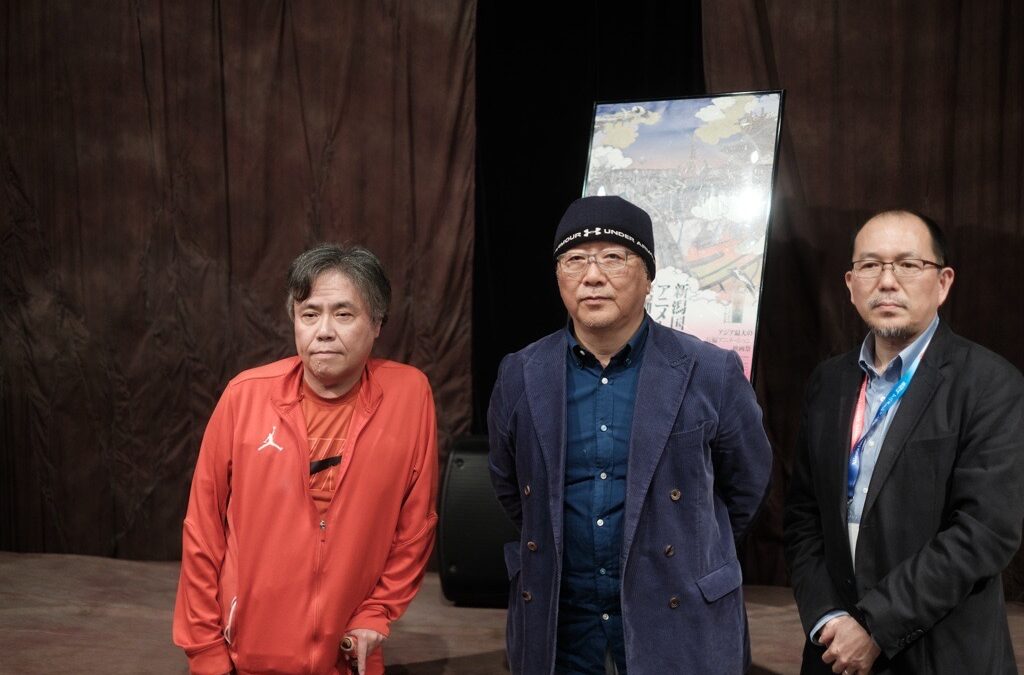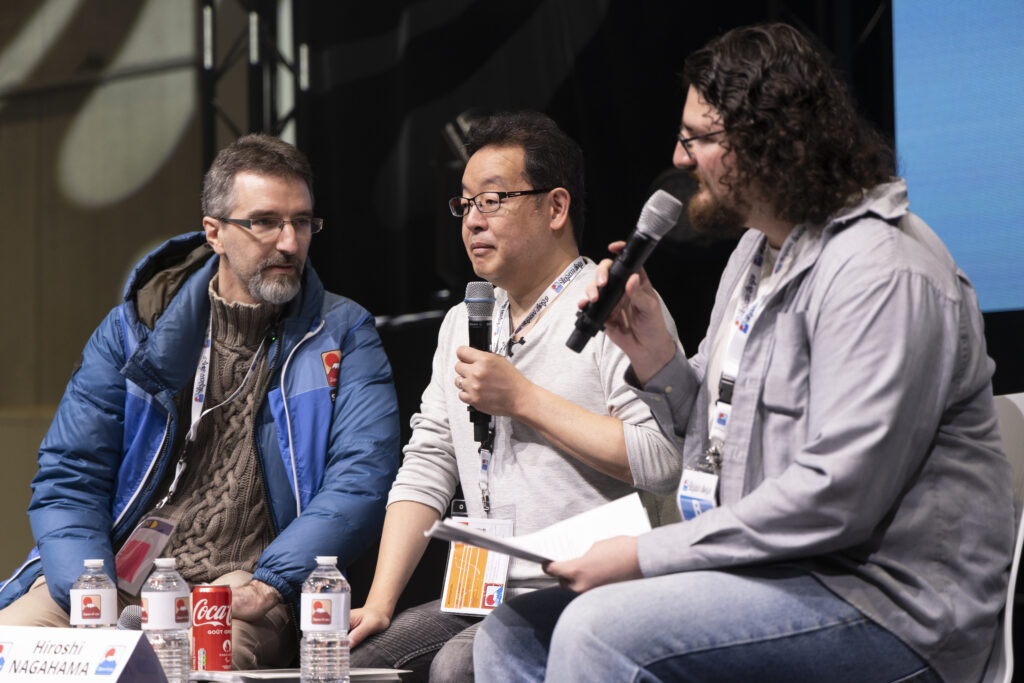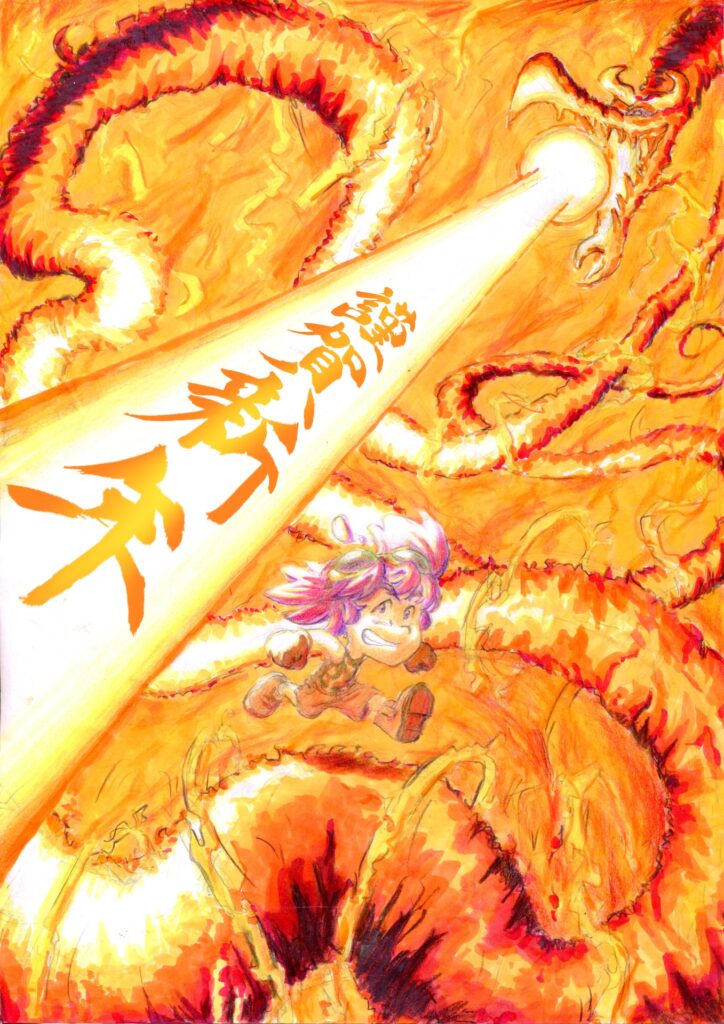Among the many events taking place during the first Niigata International Animation Film Festival was a Katsuhiro Otomo retrospective, held to celebrate the 45th anniversary of Akira and to accompany the release of Otomo’s Complete Works. All of Otomo’s animated works – those he was involved in, such as Genma Taisen, directed, such as Akira or Steamboy, and those adapted from his work – were screened. There were also multiple talk shows, including this one, hosted by director Hiroyuki Kitakubo and Katsuhiro Otomo himself.
This article would not have been possible without the help of our patrons! If you like what you read, please support us on Ko-Fi!
The two first discussed Rôjin Z, the only movie on which they really worked together. Kitakubo began with some sort of an apology, noting that “it’s the roughest work among all the Otomo-related works.” As usual, he said, it’s difficult, if not outright impossible, to reconcile deadlines and accomplish the quality you want. This became an increasingly pressing issue by the late 80s and early 90s, as more movies received corrections between their theatrical and video releases. Rôjin Z was spared this, but it happened to Akira and Grave of the Fireflies, some scenes of which were not colored when it came out in theaters. Kitakubo jokingly remarked how many people in the industry admired Takahata’s artistic sensibilities when they saw that certain scenes were only done in black-and-white line art, only to notice later that these scenes were actually unfinished!
Katsuhiro Otomo agreed with the question of creative limitations but was happy to say that he can still watch Rôjin Z today without any regrets, unlike many of his other films: precisely because he didn’t direct it, he can still have fun watching it. However, he did help out with many things: not just the script but also layouts for the tunnel scene and an interaction between the main character, Haruko, and a character he called “a dumb student”.
After their first words on Rôjin Z, both men were asked about their initial encounter. It was around 1984-1985 at Madhouse, during the production of “The Order to Cancel Construction”, a part of the Neo-Tokyo anthology. They were introduced to each other by Kôji Morimoto: he was the one who recommended Otomo to Kitakubo for the opening and ending of his own anthology, Robot Carnival. They explained that, after Genma Taisen in 1983, Madhouse received offers from Kadokawa to continue their relationship for what would become Neo-Tokyo. It was director Rintarô who invited Otomo to direct a short on it, to which he agreed. It was there that Otomo actually got to meet Madhouse’s artists, with whom he had had no contact during the production of Genma Taisen.
It was also on “The Order to Cancel Construction” that Otomo did his very first key animation: the scene where the dysfunctional robot brings increasingly poorly-made meals to the imprisoned main character.
At that point, Otomo knew nothing about how to make animation, so he was taught everything by animation director Takashi Nakamura. Indeed, Otomo knew nothing about timing and drew everything on 1s. His scenes moved way too much, and Nakamura asked him to redo it all. It’s him who taught Otomo to ”draw just the appropriate amount of movement with just the appropriate amount of drawings.” According to Otomo, he had two masters: Takashi Nakamura, the master who taught him how to animate, and Rintarô, the master who taught him how to direct.
Kitakubo, on his part, reflected on the relationship and artistic balance between Nakamura’s and Otomo’s styles. For him, “The Order to Cancel Construction” is the most “Otomo-like” in their collaborations: Nakamura’s work on Genma Taisen doesn’t really look like Otomo, while Akira’s designs and animation are more influenced by Nakamura’s sensibilities than Otomo’s according to him.
The talk then moved on to animators, with Kitakubo noting his admiration for Otomo’s collaborators, notably Takashi Nakamura and Kôji Morimoto. Otomo agreed and said that this was a special time: following works such as Space Battleship Yamato, Mobile Suit Gundam, and Galaxy Express 999, a lot of incredibly skilled animators started appearing in Japan. This trend only increased with the development of OVAs, and Otomo benefited from it.
With the mention of OVAs, the discussion moved on to Kitakubo’s directorial debut, “Pop Chaser” and the Cream Lemon series. He noted that he didn’t particularly plan to become a director but just accepted work as it came. He also revealed his secret method at the time to choose what he would work on: alongside fellow animator Hideki Tamura, they would open Animage at random and check out whatever production the page they had picked was. Then, they asked around them to see what rumors about that production said; if they were good, they’d try working on it.
As for Cream Lemon, Kitakubo was also invited by Tamura, who offered him to try porn out and introduced him to AIC. Indeed, Kitakubo revealed that most of it wasn’t actually produced at APPP as is claimed in the credits but at AIC. It was Cream Lemon producer Kazunori Nomura who led Kitakubo to direct: first, the latter was only meant to do key animation. But once he was shown the storyboards, everybody agreed that they weren’t really great, so Nomura just offered Kitakubo to direct his own episode. He was totally free: only the first episode of the series had been completed, and, in Kitakubo’s words, the template for Cream Lemon’s “genre” hadn’t really been set yet.
It’s not long after “Pop Chaser” that Nomura left AIC – he didn’t want to create porn all his life and wanted to do more diverse things such as MVs. That’s how Robot Carnival was born: he contacted many different artists to make MVs and started thinking about a theme that would link them all – it became robots.
Nomura called for Kitakubo, Nakamura, and Morimoto; Kitakubo called Yasuomi Umetsu, Hiroyuki Kitazume, and Hidetoshi Omori, while Morimoto invited animator Toshio Kawaguchi. However, Kawaguchi refused the offer to work on Ghibli’s Laputa: The Castle in the Sky, which led Manabu Ohashi to replace him.
Otomo remembered how special Robot Carnival was: every artist did nearly everything themselves, sometimes down to the in-betweens. It wasn’t the case for Otomo himself, though: Akira’s production had already begun, making him too busy. He, therefore, relied on Atsuko Fukushima’s help for the animation of the opening and ending – both he and Kitakubo expressed their admiration for her work.
Rather than discussing Akira, both directors then came back to Rôjin Z, a project born during Akira. Indeed, the two were quite friendly and often went for drinks together. One evening, Otomo said, “After Akira, let’s create something that makes money!” – which meant something with robots. As a joke, they decided to make something about an old man driving a robot simply because it had never been done before. But robots aren’t enough to sell: you also need cute girls. That’s how Haruko was born. But Otomo was aware that the girls he drew weren’t cute enough, so he was the one to suggest inviting Hisashi Eguchi. Kitakubo concluded the anecdote by saying, “You shouldn’t plan new projects while drunk.”
Though it started as a joke, the two got serious. They had a good experience at APPP during Robot Carnival, so they went to see Kazunori Nomura again. Then, work began in earnest. Otomo initially wrote his own script completely on his own, and Kitakubo went over it only when it was completed. His contributions were important, however: he claimed that he was the one who had the idea of the old man’s motivation – seeing the sea because it reminds him of his wife.
It seems like there was a lot of improvisation. Indeed, the original plan was for a 60-minute OVA – which meant a small budget. Kitakubo and Otomo were ambitious so, to get a budget raise, they sold the project as a 90-minute feature. This naturally led to changes in the plot and, notably, the extension of the climax.
Then, between the script and the storyboard, all the staff shared their own ideas and collectively defined the film’s visual identity. One of the most important artists in the team was Mitsuo Iso, credited as mechanical designer but who was also supposed to work as mechanical animation director. He left the production midway, but Kitakubo remembered that many reference drawings were still bearing his signature.
After that came the storyboard. Kitakubo’s storyboards are apparently special because of how small they are. Usually, anime storyboards are printed on B4 sheets, but back then, Kitakubo split one sheet into four pages of storyboards, making his drawings extremely small. He explained that he found such storyboards easier to manipulate for the animators: by putting more pages on a single sheet, it’s possible to have an entire shot or scene visible at one glance and it makes the flow of the action easier to understand.
The talk then finally moved on to Akira. Kitakubo remembered that he only arrived on the film mid-production and recalled the circumstances that led to it: it was thanks to Hiroyuki Yamaga. He had been close to Gainax since working on the pilot for Royal Space Force: Wings of Honneamise. Between Robot Carnival and Akira, Kitakubo was working on the MV Marionette for BOØWY. But then, Yamaga saw it and asked him, “What are you doing here? Why aren’t you on Akira?” Upon hearing this advice, Kitakubo took care of his other ongoing engagement – the opening of the Patlabor TV series – and then started working on Akira.
On his part, Otomo stated that his goal for Akira was to do something closer to American animation. It goes back to his experience working with Takashi Nakamura on “The Order to Cancel Construction”: to teach him animation, Nakamura lent him many American books, especially some about Disney’s methods. Reading them, Otomo discovered that other ways of making animation were possible, and he wanted to try them out – that’s what led, for instance, to use pre-scoring.
Another thing that made Akira special was the use of a video storyboard or animatic: it was made with a quick action recorder, and the dialogue was edited on top of it. It was sent to both the animators and music composer Shôji Yamashiro. However, Otomo couldn’t use that method for the entire film: it took too much time. It was, he said, something that happened a lot with the film: they had huge ambitions and wanted to do things differently, but reality always caught up on them, and they were forced to cut many corners.
Besides their collaborations in the 80s and early 90s, Kitakubo and Otomo share one thing: they were both pioneers of digital technologies. Their work with digital tools made up the last part of the discussion with Kitakubo starting to talk about his opening for the Ghost in the Shell PS1 game, produced at Production IG. The studio offered this work to Kitakubo following the production of Golden Boy, which is also an IG work. The director initially refused, as he didn’t want to have to copy what Oshii had done in his film, but he was convinced upon being told that what he actually needed to do was something much closer to Masamune Shirow’s manga.
After this anecdote, Kitakubo and Otomo remembered the stages of the development of digital animation in Japan. At first, computers were introduced to replace analog cel painting: by the mid-90s, most celluloid makers in Japan had closed down. Japanese studios managed to buy what they needed in Germany for some time, but that didn’t last long: the shift to digital coloring was largely imposed by economic conditions. Then came the era of “full-digital” productions: according to Otomo, the first full-digital work in Japan was Kôji Morimoto’s MV Extra. Morimoto was truly one of the pioneers of digital, as he also introduced 3DCG in his short of Memories, “Magnetic Rose”. Otomo remembered that this was a last-minute decision on Morimoto’s part and that he had to take extra illustration work for Bandai to pay for the Mac computers that Studio 4°C acquired for this occasion. In the same anthology, Otomo’s own Cannon Fodder also used digital, but Otomo himself noted that the situation was a bit different, as it was printed on film afterward. The same applies to Kitakubo’s Blood: The Last Vampire, which famously has a digital and a film version. On the other hand, the Ghost in the Shell opening is completely digital since it’s part of a video game.
Moreover, on works such as Cannon Fodder, most drawings were still done on paper and colored afterward. It’s only with Steamboy that Otomo decided to have the entire pipeline digitized. He notably used 3D backgrounds and had the background artists create textures to apply on top. For Otomo, digital completely changed both the background and photography stages: with digital, it became possible to accumulate as many layers as you want. The 4-layers limit of the analog era was, according to Otomo, one of the things that had frustrated him the most since Akira.
For Kitakubo, another advantage of digital is how it allowed production pipelines to become more streamlined across teams, projects, and studios. Indeed, in the analog days, each team and each photography director had their own “secrets of the trade” and specializations. It made it hard for the director to control everything. On the other hand, with digital, it became possible to previsualize and model everything, from the tools to the final look: on Blood, this allowed Kitakubo to make many tests with the photography and coloring teams and completely control the final look of the film.
Like our content? Feel free to support us on Ko-Fi!
You might also be interested in
Benoît Chieux, a career in French animation [Carrefour du Cinéma d’Animation 2023]
Aside from the world-famous Annecy Festival, many smaller animation-related events take place in France over the years. One of the most interesting ones is the Carrefour du Cinéma d’Animation (Crossroads of Animation Film), held in Paris in late November. In 2023,...
Directing Mushishi and other spiraling stories – Hiroshi Nagahama and Uki Satake [Panels at Japan Expo Orléans 2023]
Last October, director Hiroshi Nagahama (Mushishi, The Reflection) and voice actress Uki Satake (QT in Space Dandy) were invited to Japan Expo Orléans, an event of a much smaller scale than the main event they organized in Paris. I was offered to host two of his...
fullfrontal.moe 2023 wrap up and plans for 2024
As we enter this new year, I have grown accustomed to taking a look back at the past year to give you an idea of fullfrontal.moe's situation, what we were able to achieve together with your support and fidelity, and share our prospects for 2024. But before getting...





Recent Comments